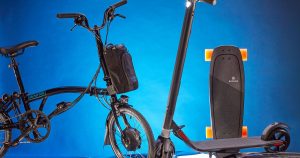In a recent stunt, a Ford crew hitched an all-electric F-150 pickup truck to a freight train filled with 42 more F-150s. Then a driver hit the throttle, and the pickup truck towed the 1.3 million-pound train. This raises some interesting questions. How hard is it for a truck to pull a train? Is that even possible? Could a normal truck do this? Of course it’s an impressive feat—but the real limiting factor is friction.
Let’s start with a more idealized situation. That’s what we do in physics—when something is potentially complicated, we make the scenario less complicated to make sure we are on the right track.
The Case With No Friction
So, what would it take to pull a giant train in the case of zero friction? The answer is that any tiny force would move the train. Even an ant could move it. Yes, this is true—it just seems impossible because you’ve never encountered a situation with zero friction. Here is a force diagram for a tiny object pulling a massive object with no friction. I’m going to use boxes to represent the objects, but if you squint real hard you can make that box look like an ant.
Rhett Allain
That diagram might look complicated, but it’s not too bad. Let me go over all the details. The first thing that might seem puzzling are those arrows over some of the symbols. You don’t really need to know about those, but that means those quantities are vectors. Yes, force is a vector. That means that pulling to the left on an object is not the same as pulling to the right. Direction matters with forces, and forces are vectors.
Next, let’s look at those two forces pulling down on block A and block B. These are the gravitational forces due to the blocks’ interaction with Earth; this is also called “weight.” The gravitational force depends on the mass of the object and the gravitational field (g), which has a magnitude of about 9.8 newtons per kilogram. This means that more massive objects have a greater weight. Oh, but you knew that—you just might not have known why you knew it. So object B has much more mass, and it has a much greater weight.
The upward-pushing force labeled N is called the normal force. This is a force between the object and the surface. If this were a train on a railroad track, the normal force would be from the rails pushing up on the train and preventing it from falling through the surface. It’s called a “normal” force because this force is always perpendicular to the surface—remember that in geometry “normal” means at a right angle. Since object B has a much greater weight, it also has a much greater normal force. It has to so that it doesn’t fall through the tracks. This normal force will become much more important when we add friction.
What about that “T” force? That is the tension force from the rope that connects object A and B. I added the subscript A-B for “A pulling on B” and B-A for “B pulling on A.” In fact, these two forces are just one interaction. Yes, forces come in pairs. If you push on the wall with your hand, the wall pushes back on you with a force of the same magnitude. Forces are always an interaction between two objects. Whatever force object A exerts on B, the same force is pushing back on A.
Now we are ready to talk about the nature of forces. It’s very common to say that a force makes things move. OK, that’s not really true. A force (actually a net force) changes the motion of an object. So, if that object is at rest then a net force will change its motion from at rest to moving. If an object is already moving, you don’t even need a net force. It will move along at a constant velocity without a force. I know this doesn’t always match up with the way people think. The problem is that there is always a frictional force—a force that is easy to pretend like it’s not there. But it is indeed there.
One last thing before getting into friction. Look back at the force diagrams for both objects. For the heavier object (B), there is a net force pulling to the left to make that object increase in velocity. That’s fine. But what about object A? For that one, there needs to be a greater force pulling to the left to overcome that tension force pulling to the right. I called this force a “thrust,” because in my mind there is a rocket on that object. I like rockets.
Pulling With Friction
Back to the F-150 pulling a train. I still have a small object (the truck) and a large object (the train). But in this case there isn’t a rocket on the truck (maybe Ford will come out with a rocket truck soon). The force pulling the truck to the left is the frictional force between the tires and the road. Without this frictional force, the truck couldn’t even accelerate. Friction is actually pretty complicated. It’s an interaction between the surface atoms in one object (the tires of the truck) and the surface atoms in another object (the ground). That’s crazy. However, we can make a fairly simple model for the magnitude of this frictional force that works in most cases (but not all cases).
In this simple friction model, the magnitude of this frictional force depends on the types of surfaces interacting (rubber and asphalt—or whatever) and the magnitude of the normal force. Yes, this is where the normal force becomes important. As an equation, I can write the maximum frictional force as the following:
Rhett Allain
What the heck is that μs thing? That’s the coefficient of static friction. It’s a value (usually less than 1) that describes how “frictiony” two surfaces are. If you rub cloth on a steel surface, the coefficient of friction would be quite low—maybe about 0.2. The coefficient of static friction for a tire on a road can be as high as about 0.7.
However, the really important part of the frictional force is the dependence on the normal force. A small object (low mass) would have a smaller gravitational force, which means it would have a smaller normal force. A smaller normal force means there would be a smaller frictional force. But let’s fix the force diagram for a small object pulling a heavy object.
Rhett Allain
What’s different in this diagram? First, there isn’t a rocket (boo). Instead, there is a frictional force pulling on the truck to the left. For the train (object B), a frictional force is pulling to the right. Since both objects have the same tension force pulling on them (but in opposite directions), the frictional force on the truck must be greater than the frictional force on the train. But wait! The frictional force depends on the mass, right? Yup. The only way for this to work is for the coefficient of friction between the truck tires and the ground to be significantly greater than the coefficient for the train wheels and the rail.
OK, I need to talk about some other friction stuff so I don’t get in trouble. The friction between the truck tires and the ground is indeed static friction. We have static friction when two surfaces are stationary with respect to each other. Even though a tire is rolling, the contact point between the wheel and ground is stationary. For the train, this would technically be kinetic friction, which happens when two surfaces move relative to each other. This happens in the axle of the train wheels. This adds a resistive force to the rolling of the wheel which tries to “slide” on the rail and that interaction is static friction. I know that’s a lot, but I feel better getting that off my chest.
Now for a quick calculation. What values of the coefficient of friction will get this to work? I don’t know the mass of an electric Ford F-150, but a normal one can be about 7,000 pounds (3,175 kilograms). Let’s just go big here. I am going to use a vehicle mass of 4,000 kg. What about the train loaded up with even more F-150s? That has a mass of 1,270,888 pounds or 576,465 kg. The frictional force on the F-150 has to be just a tiny bit greater than the frictional force on the train. Let’s set them equal to each other. That means I get the following (using the simple model for friction):
Rhett Allain
If I put in a truck coefficient of friction of 0.7 and the masses of both the truck and the train, then the coefficient of friction between the train and the rails would have to be as low as 0.0049. Yes, that’s tiny. But really, trains need to have low friction. That’s what makes them so awesome and able to transport massive amounts of cargo over great distances. But could any truck do this train pull? Based on this calculation, it’s all about the mass of the pulling vehicle and the friction between the tires and ground. So just about any truck could do this.
Oh, what about torque and power and stuff like that for the electric F-150? Yes, you need that too. But if you don’t have friction, you don’t have anything. Also, here is one of my favorite demos. Even a child can move a heavy car. Here is my daughter (when she was only 7) pulling the family car. If you get low enough friction you can get anything to move.
More Great WIRED Stories
- High drama: A cannabis biotech firm roils small growers
- Lunar mysteries that science still needs to solve
- Are super-automatic espresso machines worth it?
- The best algorithms don’t recognize black faces equally
- These hackers made an app that kills to prove a point
- ??♀️ Want the best tools to get healthy? Check out our Gear team’s picks for the best fitness trackers, running gear (including shoes and socks), and best headphones.
- ? Get even more of our inside scoops with our weekly Backchannel newsletter



